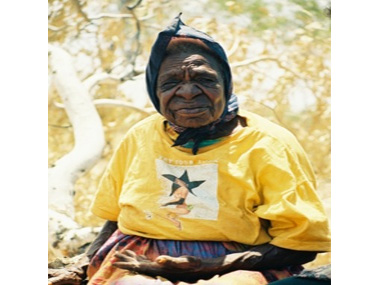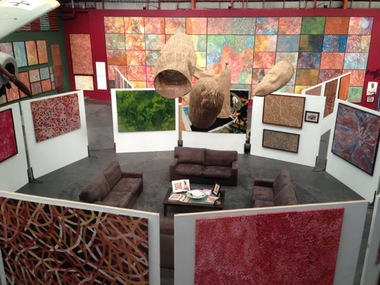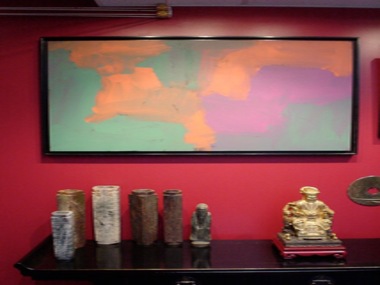THE EMILY MUSEUM

The lady herself - a favourite image of Ebes'
Posted by Aboriginal Art Directory | 07.05.13
Location: 11/15 Christensen Street, Cheltenham, Melbourne
An event of national significance occurs on Monday (May 6th) with the opening of The Emily Museum in the inauspicious setting of a converted factory in a back street in Cheltenham, the Melbourne suburb. It's not the right place – but it's the best that controversial art dealer Hank Ebes can manage at the moment – having offered his amazing collection of 243 Emily Kngwarreye paintings to both the Victorian state government if it would only build him a museum in Melbourne's city centre - preferably Federation Square – and to the briefly-considered Geelong Guggenheim.
“This art deserves it”, insists the man who is only ever seen in red patent leather shoes, and who lives with his collections – Chinese jade suits, meteorites and aeroplanes that he used to fly, hanging weirdly in amongst his Emilys. “There is no influence from any other culture on this woman. She'd have painted just as she did in the 1990s in 1810 – and that would have beaten Kandinsky to the invention of abstraction! As it is, her legacy has been compared to Monet and de Kooning; she is our heritage, and should have a solo art museum. Europe is covered in them”.
It's hard to pin the colourfully blustering Ebes down to the facts in his story. But it seems that the ex-pilot – maybe a flying doctor pilot – was tempted by the tourist trade in Aboriginal art and artefacts in early 1990 - “with a $200 limit”. But scanning the burgeoning Indigenous art scene in Melbourne, he encountered two equally colourful women – Gabrielle Pizzi and Beverley Knight, who'd got the jump on him and signed up Papunya Tula Artists and Emily Kngwarreye respectively. He also ran into the visiting Donald Holt, who just happened to own the property next to Emily's Utopia Station, and could provide an alternative supply of her work to the 'official' source, which was Rodney Gooch's CAAMA shop. These would be works created on his homestead's verandah.
Ebes flew himself to Alice Springs and bought 120 Kngwarreyes on the spot – before falling out with Holt. For a while, three agents worked for him in the area picking up what they could. But then Ebes met the influential trio of Barbara Weir, her son Fred Torres and her mother Minnie Pwerle – related to Emily and able to supply the dealer with many of the 650 Emilys he says passed through his hands. These included many of the amazing last suite of 24 which would later send the Japanese into mild paroxisms of Zen appreciation when Kngwarreye had solo shows in Osaka and Tokyo a few years ago.
The marvellous grey wash work which appeared on the cover of those shows' catalogue was only lent by Ebes on condition it took that prime spot. He was not happy that his own plans for an Aboriginal art tour in Japan had been forestalled by the National Museum's 'official' effort. And he did have credibility in this area having realised the need to promote Aboriginal art through 15 years of touring a collection he called Nangara across the States and Europe, backed by an informative catalogue. Fortunately, Ebes had good contacts in high places – such as the Directors of the van Gogh Museum and the Rijksmuseum, who both advised and bought Aboriginal art.
As a result, Hank Ebes can look down from his living quarters in the Museum upon the full range of Emily's dynamically changing style – seven, he asserts, including a brief and therefore rare series in ochres not acrylics. But by far his greatest pleasure comes from the perfectly positioned Emily Wall facing his window, consisting of 53 panels that reflect the changing seasons in the Utopian artist's life. It spreads glowingly across 15 metres in width and 5 metres high, and is laid out in precisely the order the artist determined. It's never been seen publicly in Australia before.
Inherently Hank Ebes is a businessman rather than a philanthropist. He could afford not to sell his horde of Emilys because his Aboriginal Gallery of Dreamings in Melbourne's CBD was successful and at one time contained the artwork that would set the still-record price for an Aboriginal artwork at auction - $2.4 million. The National Gallery bought Clifford Possum's Warlugulong in that 2007 sale – with Victoria once again missing out on an offer by Ebes to sell it to the NGV for much less as long as it went on permanent exhibition.
However, running the new Emily Museum at a cost, he estimates, of half a million dollars a year is beyond him. It's being funded by his own private auctions – two a year of works left over from the 12,000 which passed through the City gallery when it closed in 2008. No buyers' premiums are charged – but clearly the late series Emily offered in November last year failed to sell at half a million dollars – it would have done the job all on its own.
“I'm 69, I've had a quadruple heart bypass, and I could drop dead at any minute”, the dealer pointed out, “so I want this set up properly to be my legacy as well as her's. I admit that my ego has occasionally stood in the way in my life; but when I'm dead, I'll go from arrogant shit to genuine expert!”.
Oddly enough, Ebes seems to have had fairly few direct dealings with Emily Kngwarreye herself. However, there was an occasion when he'd been touring her work – including the Emily Wall – for a while and tried to tell her that she could retire on the travelling royalties she would receive. Without even considering the possibility, Emily hurled a paintbrush at him and cried, “I no paint, I die”.
With a Museum like this – even one in Cheltenham (“the centre of Melbourne by population – and only 5 minutes from two stations”, Ebes informs me) – Emily Kngwarreye will never die.
Former Federal Arts Minister Richard Alston does the opening honours.
URL: Emily Museum
Share this:
»  del.icio.us
»
del.icio.us
»  Digg it
»
Digg it
»  reddit
»
reddit
»  Google
»
Google
»  StumbleUpon
»
StumbleUpon
»  Technorati
»
Technorati
»  Facebook
Facebook
Contact Details

The 'Emily Wall' from Hank Ebes' window - with just the hint of an aeroplane prop on the left

A wonderful 'late' Emily 'Untitled' with a small part of Ebes' Chinese collection
Further Research
Artists: Emily Kngwarreye
News Tags: Aboriginal Gallery of Dreamings | Emily Kngwarreye | Hank Ebes | Utopia
News Categories: Event
Exhibition Archive
- 10.10.17 | TARNANTHI 2017
- 11.08.17 | Natsiaas 2017
- 20.07.17 | APY ART DOMINATES THE WYNNE
- 17.07.17 | Anangu Artist Wins $100,000 Prize
- 14.07.17 | The End of AAMU
- 11.07.17 | ART ACROSS THE COUNTRY
- 11.07.17 | TARNANTHI IN OCTOBER
- 05.07.17 | TJUNGUṈUTJA - from having come together
- 13.06.17 | Ghost-Nets Straddle the World
- 07.06.17 | Grayson Perry Going Indigenous?
- 05.06.17 | Barks Bigger than Ben Hur
- 27.05.17 | NGA QUINQUENNIAL 2017
- 21.05.17 | Blak Douglas Finds Home at the NGA
- 21.05.17 | BRIAN ROBINSON WINS HAZELHURST WOP
- 18.05.17 | PARRTJIMA 2.0
Advertising

